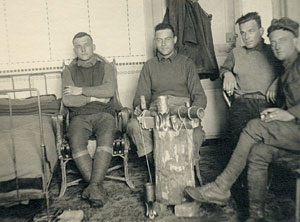Warfare Crafted Into Works of Art
 Capper artillery shell casings decorated with copper sun, stars, the Ten Commandments tablets and the skyline of Jerusalem.
Capper artillery shell casings decorated with copper sun, stars, the Ten Commandments tablets and the skyline of Jerusalem. Photograph courtesy of Jane Kimball
Somewhere in between war and peace lies trench art, a memorable type of folk art created by soldiers from war debris.
The trench art term, according to Jane Kimball, author of Trench Art: An Illustrated History , was coined during World War I by popular French magazine, Les Pays de France.
"They sponsored a series of competitions for the best art pieces made by French soldiers, l'artisanat des tranchées," says Kimball. "Translated into English as trench art, this term has been used ever since to describe a wide variety of war souvenirs crafted by soldiers."
World War I spawned a network of trenches dug from Belgium to Switzerland. Millions of brass-cased artillery shells would be fired by the armies of the allies and the Central Powers. "Troops were rotated out of the front line into reserve trenches far from the fighting and, with the litter of previous battles all around, found ample material with which to work," says Kimball. "Other shell casings were decorated by prisoners of war and by convalescent soldiers."
Shell casings decorated by Belgian and French soldiers were first sent home to relatives; the allies then began to sell them as souvenirs to British and American soldiers as souvenirs, who then began designing their own trench art.
Kimball says brass was the "ideal canvas for the creation of artistic vases." The shell casings were engraved with names of battles, figures or a soldier's war service, and the background would feature a zigzag "wigglework" pattern.
Melted lead or sand were poured into casings, annealed and heated several times, and embossed or hammered.
"Early shells were engraved or embossed with everything from tools made from bedsprings or screwdrivers," says Kimball. "Later in the war, commercial firms in Paris sold embossing tools and paper patterns."
 American soldiers of Company A of the 23rd Engineers Corps decorating shell casings.
American soldiers of Company A of the 23rd Engineers Corps decorating shell casings. Photograph courtesy of Jane Kimball
Acid etching was another trench art technique, created with wax and an acid bath; shell casings with a flute shape were heated and hammered; and flat casings were transformed into inkwell sets, letter openers, clock surrounds, picture frames, matchbox covers, lighters, and tobacco humidors. Miniature models of tanks, airplanes and submarines are also unique works of trench art from World War I.
After World War I, students at the Bezalel School of Arts & Crafts decorated shell casings with Jewish images and scenes of the Holy Land.
"In World War II," says Kimball, "the American Seabees, a branch of the U.S. Navy, traveled from place to place building roads, air strips and landing docks to support American troops. They developed a cottage industry in trench art, collecting spent shell casings at one port and decorated them for sale at their next port."
From World War II, trench art became more obsolete during the Korean and Vietnam wars. "And the Iraq and Afghanistan war has changed again," says Kimball. "Soldiers now have turned most of their creative talents to creating blogs on cyberspace."
But Kimball says contemporary artists like Rik Ryon of Poperinge, Belgium, have kept the spirit of these warfare works of art alive through his copper sculptures made from original World War I shell driving bands.
Resources:
Also in this Issue:
- The Mica Lamp Company: Beautiful Lighting Inspired by Turn-of-the-Century Craftsmanship
- Warfare Crafted Into Works of Art
- Seeing the Future: Copper Braille Jewelry
- 2-Roses Studio: A Lifelong Journey of Exploration and Experimentation
- Rare Rembrandt Self-Portrait Rediscovered
